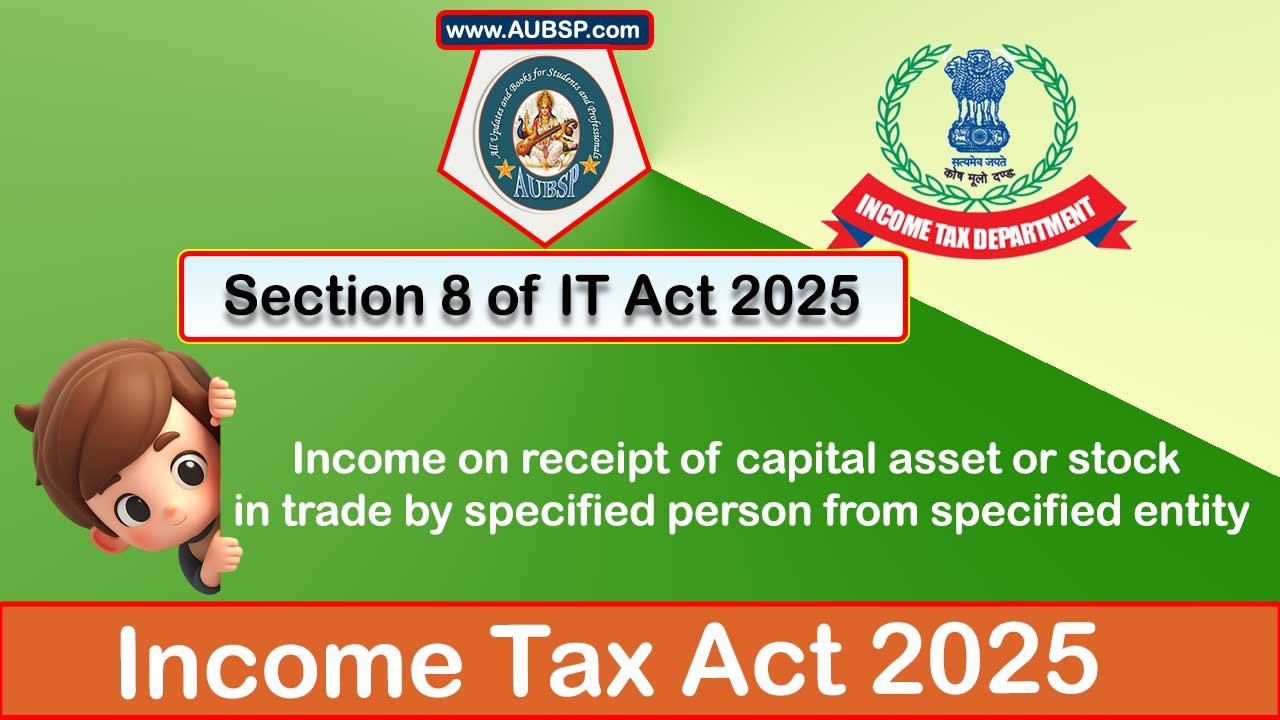Section 8 of the Income Tax Act, 2025, effective from April 1, 2026, addresses the tax implications when a specified person—such as a partner in a firm or a member of an association of persons (AOP) or body of individuals (BOI), excluding companies and cooperative societies—receives capital assets or stock-in-trade from a specified entity during its dissolution or reconstitution. In such cases, the specified entity is deemed to have transferred these assets to the specified person in the year of receipt.
The fair market value of the assets on the date of receipt is considered the full value of consideration for this deemed transfer. Consequently, any profits or gains arising are treated as income of the specified entity for that tax year and are taxable under the head “Profits and gains of business or profession” or “Capital gains,” as applicable. The Act also empowers the Central Board of Direct Taxes (CBDT) to issue guidelines, with prior government approval, to address any implementation challenges, provided such guidelines are issued within two years from April 1, 2026, and are subsequently laid before Parliament.
Income on receipt of capital asset or stock in trade by specified person from specified entity
[Section 8 as per the Income Tax Act, 2025 (this Act) w.e.f. 1st April, 2026.]
Section 8(1) of Income Tax Act 2025
8(1) Where a specified person receives during the tax year any capital asset or stock-in-trade or both from a specified entity in connection with the dissolution or reconstitution of such specified entity, then the specified entity shall be deemed to have transferred such capital asset or stock-in-trade, or both, to the specified person in the year in which such capital asset or stock-in-trade, or both, are received by the specified person.
Section 8(2) of Income Tax Act 2025
8(2) Any profits and gains arising from the deemed transfer mentioned in sub-section (1) by the specified entity shall be—
- (i) deemed to be the income of such specified entity of the tax year in which such capital asset or stock-in-trade or both were received by the specified person; and
- (ii) chargeable to income-tax as income of such specified entity under the head “Profits and gains of business or profession” or under the head “Capital gains”, as per this Act.
Section 8(3) of Income Tax Act 2025
8(3) In this section, fair market value of the capital asset or stock-in-trade, or both, on the date of its receipt by the specified person shall be deemed to be the full value of the consideration received or accruing as a result of such deemed transfer mentioned in sub-section (1).
Section 8(4) of Income Tax Act 2025
8(4) If any difficulty arises in giving effect to the provisions of this section and section 67(10), the Board may, with the previous approval of the Central Government issue guidelines for removing the difficulty.
Section 8(5) of Income Tax Act 2025
8(5) No guideline under sub-section (4) shall be issued after the expiration of two years from the 1st April, 2026.
Section 8(6) of Income Tax Act 2025
8(6) Every guideline issued by the Board under sub-section (4) shall be laid before each House of Parliament while it is in session for a total period of thirty days which may be comprised in one session or in two or more successive sessions, and if, before the expiry of the session immediately following the session or the successive session aforesaid, both houses agree in making any modification in such guideline or both Houses agree that the guideline, should not be issued, the guideline shall thereafter have effect only in such modified form or be of no effect, as the case may be; so, however, that any such modification or annulment shall be without prejudice to the validity of anything previously done under that guideline.
Section 8(7) of Income Tax Act 2025
8(7) In this section,—
- (a) “specified entity” means a firm or other association of persons or body of individuals (not being a company or a co-operative society);
- (b) “specified person” means a person, who is a partner of a firm or member of other association of persons or body of individuals (not being a company or a co-operative society) in any tax year;
- (c) “reconstitution of the specified entity” means, where—
- (i) one or more of its partners or members, of such specified entity ceases to be partners or members; or
(ii) one or more new partners or members are admitted in such specified entity in such circumstances that one or more of the persons who were partners or members, of the specified entity, before the change, continue as partner or partners or member or members after the change; or
(iii) all the partners or members, of such specified entity continue with a change in their respective share or in the shares of some of them.
- (i) one or more of its partners or members, of such specified entity ceases to be partners or members; or
FAQs on Section 8 of the Income Tax Act 2025
1. What is the key provision under Section 8(1) of the Income Tax Act, 2025?
Section 8(1) states that when a specified person receives a capital asset or stock-in-trade from a specified entity due to its dissolution or reconstitution, the specified entity is deemed to have transferred such assets to the specified person in the year of receipt.
2. Who is considered a ‘specified person’ under this section?
A ‘specified person’ refers to a person who is a partner of a firm or a member of an association of persons (AOP) or body of individuals (BOI), excluding companies and cooperative societies, in any tax year.
3. What qualifies as a ‘specified entity’?
A ‘specified entity’ is defined as a firm, an association of persons (AOP), or a body of individuals (BOI), but does not include companies or cooperative societies.
4. When does the deemed transfer occur under Section 8?
The deemed transfer occurs in the tax year in which the specified person receives the capital asset or stock-in-trade from the specified entity.
5. How is the deemed transfer treated for tax purposes?
As per Section 8(2), the profits and gains arising from the deemed transfer are:
(i) Treated as income of the specified entity in the tax year when the asset is received by the specified person.
(ii) Taxable under the head “Profits and Gains of Business or Profession” or “Capital Gains” based on the nature of the asset transferred.
6. How is the value of the deemed transfer determined?
According to Section 8(3), the fair market value (FMV) of the capital asset or stock-in-trade on the date of receipt by the specified person is considered the full value of the consideration for tax purposes.
7. What happens if there is a reconstitution of the specified entity?
Reconstitution occurs when:
- One or more partners/members exit.
- New partners/members join, but some existing ones remain.
- All partners/members continue, but their shareholding changes.
In such cases, any capital asset or stock-in-trade received by a specified person is deemed transferred by the specified entity.
8. What if the provisions of Section 8 create difficulties in implementation?
Section 8(4) allows the Board, with prior approval of the Central Government, to issue guidelines to remove any difficulties in implementing this section and Section 67(10).
9. Is there a time limit for issuing such guidelines?
Yes, as per Section 8(5), no guidelines can be issued after two years from April 1, 2026.
10. How are these guidelines approved?
Section 8(6) mandates that any guidelines issued must be laid before both Houses of Parliament for 30 days. If both Houses modify or reject the guidelines, they will be applicable only in the modified form or will be annulled without affecting past actions.
11. How does this section impact taxation on business restructuring?
When a firm or an AOP/BOI is dissolved or reconstituted, and assets are distributed to partners/members, the firm or entity is liable to pay tax on any capital gains or business profits arising from the transfer.
12. Will the specified person also be taxed on receiving the asset?
Section 8 primarily imposes tax liability on the specified entity for the deemed transfer. However, the specified person may be taxed in accordance with other provisions of the Income Tax Act, such as capital gains on a subsequent sale.
13. What is the significance of ‘fair market value’ in taxation under this section?
The FMV of the capital asset or stock-in-trade is considered the full value of consideration for computing the taxable profits/gains of the specified entity. This prevents undervaluation of assets to evade taxes.
14. Will the transfer be taxed if it is made without consideration?
Yes, even if the specified person receives the asset without consideration (i.e., as part of dissolution or reconstitution), the specified entity is still deemed to have transferred it and is taxed accordingly.
15. Does this section apply to companies or cooperative societies?
No, Section 8 applies only to firms, AOPs, and BOIs. Companies and cooperative societies are excluded from the definition of “specified entity.”
16. What are the compliance requirements for a specified entity under this section?
The specified entity must:
- Report the deemed transfer in its income tax return.
- Compute and pay tax on the deemed profits/gains.
- Maintain records supporting the FMV of the asset transferred.
17. How does this section interact with other provisions of the Income Tax Act, 2025?
Section 8 must be read along with other provisions, such as capital gains tax rules and business income provisions. Additionally, it refers to Section 67(10), which may have related implications.
18. What happens if the specified person sells the asset received?
If the specified person later sells the asset, they will be liable for capital gains tax based on their holding period and cost of acquisition, as per the Income Tax Act.
19. Can a specified entity claim any exemptions on the deemed transfer?
No specific exemptions are provided under Section 8. However, other provisions of the Act may offer relief in certain cases.
20. How does this section impact restructuring strategies of firms and AOPs?
This section ensures that any transfer of assets during dissolution or reconstitution is taxed, preventing tax avoidance strategies such as undervaluation or tax-free transfers. Firms and AOPs must plan their restructuring accordingly to minimize tax liabilities.
Section 8 of the Income Tax Act, 2025, establishes a clear framework for taxing the transfer of capital assets or stock-in-trade when received by a specified person from a specified entity due to dissolution or reconstitution. It ensures that such transfers are treated as deemed transfers by the specified entity, with tax implications under “Profits and Gains of Business or Profession” or “Capital Gains.”
By using the fair market value as the benchmark for taxation, the provision prevents tax evasion through undervaluation of assets. Additionally, it grants the tax authorities the power to issue clarifying guidelines, with parliamentary oversight ensuring transparency.
This section significantly impacts firms, associations of persons (AOPs), and bodies of individuals (BOIs), making it essential for them to carefully plan restructurings to manage tax liabilities effectively. While it primarily taxes the specified entity, specified persons may also have tax implications upon subsequent disposal of received assets.
In summary, Section 8 reinforces tax compliance in business restructurings and dissolutions, closing potential loopholes while providing clarity on taxation responsibilities.


